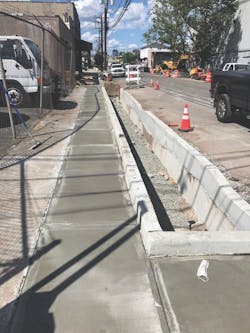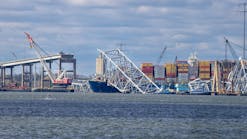About the author:
Lori Wade, P.E., is department manager – Water for Michael Baker International. Wade can be reached at [email protected].
by Lori Wade
undefinedDeep in the heart of New Jersey lies “The Ironbound” community, a working-class, multi-cultural neighborhood. Encompassing four square miles of the city of Newark, Essex County, the small enclave is home to more than 570 businesses and nearly 50,000 residents. The area includes critical corridors for a mix of commercial, freight and passenger vehicles destined for Route 21, Route 1 and 9, New Jersey Turnpike, Newark Liberty International Airport, Port Newark Terminal and Newark’s Industrial Park, as well as the metropolitan New York City area. The Ironbound Community is bordered by the Passaic River to the north, a freight railroad corridor to the south and major urban arterials to the east and west.
The Ironbound community is a force in the economy, however, it had a problem that threatened safety and mobility: the highly urbanized area was experiencing serious flooding and drainage issues. The area lies in a topographic depression that cannot drain efficiently by gravity sewers alone and was developed with an approximate impervious coverage of 70%, leaving much of the landscape unable to effectively absorb or infiltrate rainfall. Heavy rains regularly led to extreme flooding conditions, creating dangerous safety concerns as well as impeding the flow of traffic.
Creating safer, more efficient water systems was of the utmost importance to the city of Newark. Previously, all flow was conveyed to the Passaic Valley Sewerage Commission (PVSC) during dry weather. During wet weather and snow melt, the combination of storm water and wastewater in the CSS often exceeded the capacity of the system. The excess flow, combined sewer overflow (CSO), was discharged directly to a waterway through permitted outfall pipes. Since CSO discharges include raw sewage, they contain a combination of untreated human waste and pollutants discharged by commercial and industrial establishments. CSOs also have a significant storm water component that includes pollutants from urban and rural runoff. These pathogens, solids and toxic pollutants were discharged directly to the waters of the state during wet weather events.
Solving Flooding & Drainage Issues
To tackle the flooding and drainage issues in the key area of South Street and Adams Street, the city of Newark engaged engineering, planning and consulting firm Michael Baker International to complete a conceptual design study and also serve as the lead designer and construction manager for the project. Before any work began on the project, Michael Baker worked with the city to create a scope for the project and explored many alternatives during the concept study phase. In addition, the team worked with the neighborhood residents and business owners to solicit their input, which impacted the final design and construction for the project. The various options – including raising the roadway and adding pump stations – were provided to the city of Newark before the final design components were selected.
The final design incorporated roadway resurfacing, sidewalk, curb and ADA curb ramp improvements, new drainage inlets, manholes and pipes to begin the separation of storm water from the CSO culverts. The new pipe systems, carrying storm water runoff, tie into the CSO culvert after the CSO screen chamber. More than 4,000 linear feet of deteriorated corrugated metal pipe was replaced and existing pipe to remain was cleaned. Green infrastructure (GI) was constructed on Avenue A, at the Intersection of South and Adams Street, as well as along South Street, including curb inlets with planted areas between the curb and sidewalk. As construction began, the team encountered significant utility conflicts that could not be identified during design. In some cases, redesigns needed to be completed while construction was in progress and the pump station location had to be shifted as a result of these previously unidentified utilities.
The team also incorporated additional improvements that would enhance the area into the design. Prior to the drainage improvements, the existing sidewalks and business parking lots were beginning to deteriorate. The team redesigned the sidewalk to be 10 feet wide where feasible, making better use of the existing space and offering more walkability than the area previously experienced. The project team also helped local businesses by adding new curbing for driveways that extended further than was necessary.
Focusing on a Greener Tomorrow
Managing storm water runoff and implementing green infrastructure is a key component of the city of Newark’s strategy to reducing CSOs and has been identified in Newark’s Sustainability Action Plan, the city of Newark Master Plan and Newark’s Greenstreets Initiative. The city’s vision for storm water is to “use its land to absorb storm water before it gets into the sewer system and do that in ways that also cool and beautify its neighborhoods.” Benefits of GI include improved water quality and reduced sewer overflow; financial benefits in the form of reduced construction costs compared with all-grey infrastructure; and social benefits like improved aesthetics, more urban greenways and increased public awareness and education on their role in storm water management.
By incorporating GI into the South Street and Adams Street Drainage Improvements project, storm water can be captured before it reaches the sewer system, thus reducing flooding and occurrences of CSOs. In addition, GI creates more permeable surfaces, which can also assist to reduce ambient air temperatures, provide open space, improve air quality, lower energy demand and reduce greenhouse gas emissions. These factors can also contribute to the frequency and severity of CSO events. New GI in The Ironbound Community includes 50 to 100 feet planter boxes and tree trenches to help reduce flooding and filter sediment before that water discharges down through the system.
Looking to the future, the team decided to utilize oversize pipes in the project’s design to allow for eventual connections. In addition, the team considered future impact by designing the pump station to incorporate a connection from the adjacent property owner, whose land was also prone to flooding.
The drainage improvements on South Street and Adams Street have helped to reduce the impact of heavy rain events on the city of Newark’s infrastructure. The reduction in flooding has made the area safer for residents, pedestrians and motorists alike. Overall, the project has achieved its goal of alleviating flooding, managing storm water runoff and increasing sustainability for a community in significant need of new infrastructure.






